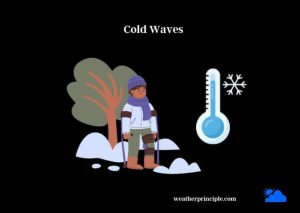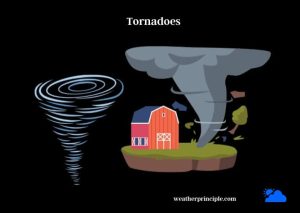Published on: February 29, 2024
Written by Shaown Khan / Fact-checked by Kader Khan
Hurricanes and typhoons are two names for the same phenomenon—powerful tropical cyclones that form over warm ocean waters. The primary distinction between the two lies in their location: hurricanes form in the Atlantic Ocean and Eastern Pacific, while typhoons develop in the Western Pacific. These massive storms are known for their destructive force, bringing heavy rains, strong winds, and devastating storm surges to coastal regions.
The Role of Climate in Storm Formation
The Earth’s climate plays a critical role in the formation and behavior of hurricanes and typhoons. Factors such as ocean temperatures, wind patterns, and atmospheric conditions all contribute to the development and strength of these storms. As climate change accelerates, understanding the relationship between our warming planet and tropical cyclones becomes increasingly important for predicting and preparing for their impacts.
Historical Context
Tropical Storms
Throughout history, hurricanes and typhoons have been both feared and respected for their power. Ancient civilizations often attributed these storms to the wrath of gods or other supernatural forces. Scientific understanding of tropical cyclones has evolved significantly since then, with major advancements in meteorology and technology helping to shed light on their formation and behavior.
Major Hurricanes and Typhoons in History
Some of the most notorious hurricanes and typhoons include the Galveston Hurricane of 1900, Hurricane Katrina in 2005, Typhoon Haiyan in 2013, and Hurricane Harvey in 2017. These storms are remembered not only for their destructive power but also for the lessons they provided in storm preparedness, recovery, and resilience.
The Evolution of Storm Tracking and Forecasting
Early storm tracking and forecasting relied on rudimentary methods, such as observing cloud formations and changes in atmospheric pressure. Today, advanced satellite technology, computer modeling, and meteorological research have revolutionized our ability to predict and monitor hurricanes and typhoons, helping to save lives and minimize damage.
The Storm Formation
The Ingredients for a Hurricane or Typhoon
Three main factors are required for a hurricane or typhoon to form: warm ocean water, atmospheric instability, and weak vertical wind shear. Warm ocean waters provide the heat energy necessary for storm development, while atmospheric instability and weak wind shear allow the storm system to organize and intensify.
How Storms Develop and Strengthen
Hurricanes and typhoons begin as small disturbances in the atmosphere, often triggered by a cluster of thunderstorms. As these disturbances feed off the warm ocean water, they grow in size and strength. The Earth’s rotation causes the storm system to spin, organizing the system into a tropical depression, tropical storm, and eventually a hurricane or typhoon.
Weather Patterns and Their Effects on Storm Behavior
Weather patterns, such as El Niño and La Niña, can influence the frequency and intensity of hurricanes and typhoons. These patterns alter global wind and temperature patterns, impacting the conditions necessary for storm formation.
The Impact of Climate Change
A Warmer World and Storm Intensity
As the Earth’s climate warms, ocean temperatures rise, providing more fuel for hurricanes and typhoons. This leads to an increased likelihood of stronger, more intense storms. A warmer atmosphere can hold more moisture, increasing the potential for heavier rainfall during these storms.
Sea Level Rise and Coastal Vulnerability
Rising sea levels due to climate change exacerbate the impacts of storm surges during hurricanes and typhoons. As water levels increase along coastlines, even moderate storms can cause significant flooding and damage to coastal communities, making them more vulnerable to the destructive force of these cyclones.
The Future of Hurricanes and Typhoons
The relationship between climate change and tropical cyclones is crucial for preparing for future storms. Although there is still much to learn, current research suggests that we may see an increase in the frequency of the most intense storms, posing significant challenges for coastal communities and infrastructure.
The Anatomy of a Storm
The Eye of the Hurricane
At the center of a hurricane or typhoon lies the eye, a relatively calm area characterized by low pressure, light winds, and clear skies. Typically ranging from 20 to 40 miles in diameter, the eye is surrounded by the eyewall, where the storm’s most intense winds and heaviest rainfall occur.
The Eyewall and Rainbands
The eyewall consists of towering clouds and powerful winds that spiral around the eye. These winds drive warm, moist air upward, fueling the storm’s intensity. Beyond the eyewall, bands of heavy rain known as rainbands spiral outwards, contributing to the storm’s overall size and reach.
Storm Surge and Flooding
Storm surge is the rise in seawater level caused by a hurricane or typhoon’s strong winds. This surge, combined with normal tides and heavy rainfall, can lead to widespread flooding and significant damage to coastal areas.
Classifying Storms: The Saffir-Simpson Scale
Categories and Wind Speeds
The Saffir-Simpson Hurricane Wind Scale is used to classify hurricanes and typhoons based on their maximum sustained wind speeds. The scale ranges from Category 1, with winds of 74-95 mph, to Category 5, with winds exceeding 157 mph. Each category corresponds to the storm’s potential for damage and flooding.

Limitations and Criticisms
While the Saffir-Simpson Scale provides a useful way to categorize storm intensity, it has its limitations. The scale focuses solely on wind speeds and does not account for other factors, such as storm surge or rainfall, which can also have significant impacts.
Hurricane and Typhoon Preparedness
Personal Safety Measures
Preparing for a hurricane or typhoon involves creating an emergency plan, assembling a disaster supply kit, and staying informed about the storm’s progress. Securing your home, knowing evacuation routes, and establishing a communication plan with family members can also help ensure your safety during a storm.
Community Response and Evacuation Plans
Effective community preparedness includes well-coordinated evacuation plans, public information campaigns, and the establishment of emergency shelters. Local governments and organizations play a crucial role in ensuring that residents are informed and equipped to respond to hurricanes and typhoons.
Building Resilient Infrastructure
Investing in resilient infrastructure, such as elevated buildings, flood barriers, and improved drainage systems, can help minimize the damage caused by hurricanes and typhoons. These measures not only protect property but also save lives by reducing the risk of flooding and structural failures.
Economic and Social Impact
The Cost of Destruction
The economic impact of hurricanes and typhoons can be staggering, with damage costs often reaching billions of dollars. These storms can disrupt local economies, destroy infrastructure, and strain resources for years after the event. The cost of recovery and reconstruction can place significant burdens on governments, businesses, and individuals alike.
Environmental Consequences
Hurricanes and typhoons can cause extensive damage to ecosystems and natural resources. They can lead to coastal erosion, saltwater intrusion into freshwater systems, and the loss of critical habitats for plants and animals. The heavy rains and flooding associated with these storms can result in water pollution and long-lasting damage to agricultural land.
Displacement and Humanitarian Crises
The human toll of hurricanes and typhoons can be immense. These storms often result in the displacement of large populations, creating humanitarian crises as people struggle to access basic necessities like food, water, and shelter. In the aftermath of these events, the risk of disease outbreaks, mental health issues, and social unrest can further exacerbate the challenges faced by affected communities.
Recovery and Reconstruction
Lessons Learned from Past Storms
Each hurricane or typhoon provides valuable lessons in storm preparedness, response, and recovery. By analyzing the successes and failures of past events, governments, organizations, and individuals can develop more effective strategies to mitigate the impacts of future storms.
Innovative Solutions for Rebuilding
Innovative approaches to rebuilding after hurricanes and typhoons can help create more resilient communities. These solutions may include adopting green infrastructure, implementing adaptive building designs, and utilizing renewable energy sources to reduce the vulnerability of communities to future storms.
Investing in Resilience and Adaptation
Investing in resilience and adaptation measures can significantly reduce the long-term costs of recovery from hurricanes and typhoons. This includes funding research, improving early warning systems, and supporting the development of new technologies that can help protect lives, property, and ecosystems from the devastating impacts of these storms.
Conclusion
The Ever-Present Threat of Hurricanes and Typhoons
Hurricanes and typhoons pose an ongoing threat to coastal communities around the world. As climate change continues to influence the intensity and behavior of these storms, it is more important than ever to invest in preparedness, resilience, and adaptation measures to minimize their impacts.
A Call for Global Cooperation and Preparedness
Addressing the challenges posed by hurricanes and typhoons requires global cooperation and a shared commitment to preparedness. By working together to improve our understanding of these storms and investing in the necessary infrastructure and resources, we can help protect our planet and its inhabitants from the destructive force of hurricanes and typhoons.
Summary
In this article, we explored the nature of hurricanes and typhoons, delving into their formation, historical context, and the role of climate change in their behavior. We examined the anatomy of these storms and the methods used to classify them, as well as the importance of preparedness, resilience, and adaptation in mitigating their impacts.
We discussed the economic, social, and environmental consequences of hurricanes and typhoons, highlighting the need for global cooperation in addressing the challenges they present.
Frequently Asked Questions (FAQs)
What is the difference between a hurricane and a typhoon?
Both hurricanes and typhoons are tropical cyclones, with the main difference being their location. Hurricanes form in the Atlantic Ocean and Eastern Pacific, while typhoons develop in the Western Pacific.
Can hurricanes and typhoons be prevented or weakened?
While we cannot prevent hurricanes and typhoons from forming, ongoing research aims to better understand and predict their behavior, which could help minimize their impacts through improved preparedness and response measures. However, current technology does not allow us to weaken or control these storms directly.
What steps can individuals take to prepare for a hurricane or typhoon?
Individuals can prepare for a hurricane or typhoon by creating an emergency plan, assembling a disaster supply kit, securing their homes, staying informed about the storm’s progress, knowing evacuation routes, and establishing a communication plan with family members.
How are hurricanes and typhoons named?
Hurricanes and typhoons are named using a pre-determined list of names created by the World Meteorological Organization. Each list is used on a six-year rotating basis, with names being retired if they are associated with particularly devastating storms.
What role do governments and international organizations play in hurricane and typhoon response?
Governments and international organizations play critical roles in hurricane and typhoon response by providing early warning systems, coordinating evacuation plans, establishing emergency shelters, offering financial assistance for recovery efforts, and supporting research to improve our understanding of these storms and their impacts.



